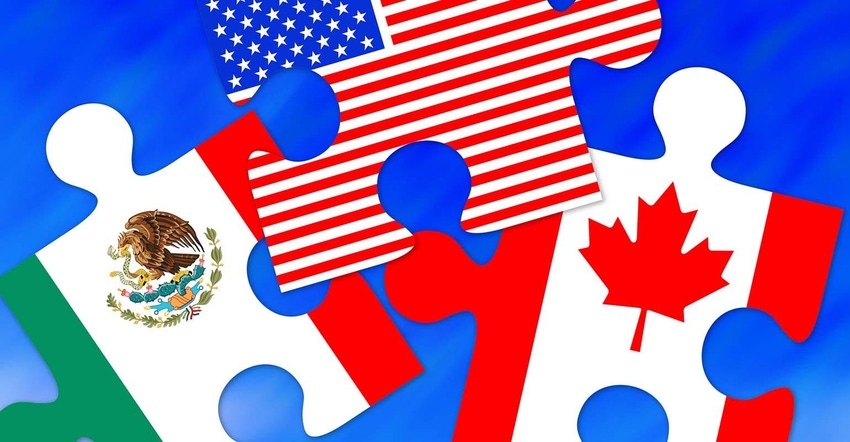
Editor's Note:
President Trump announced Monday that the United States and Mexico will sign a new bi-lateral trade agreement, leaving Canada out of the pact, at least for now. Trump also noted that the term NAFTA will be dropped because of negative connotations. He also said he will speak with the Canadian Prime Minister to begin negotiations.
If agriculture were the main issue in renegotiating the North America Free Trade Agreement, it would be done already, says Texas A&M Extension economist Luis Ribera.
Ribera, director of the Center for North American Studies and program director for International Projects with the Agricultural and Food Policy Center at A&M, discussed NAFTA during a 90-minute University of Arkansas webinar, Agricultural Trade: China, NAFTA and Brazilian Agriculture in Focus.
See also:
Part 1: Trade wars hurt producers, consumers
The presentation was one in a series of University of Arkansas webinars hosted by Extension economist Bobby Coats.
Some agricultural issues offer challenges — dairy, poultry and eggs — Ribera says, but the main issues are non-ag related.
“Agriculture accounts for only 6 percent to 7 percent of NAFTA,” he explains. “That’s a small piece of the pie.”
He says the auto industry remains a big sticking point. “Once we get an agreement on auto issues, everything will fall into place. I think we are close to a deal.”
Ribera says, despite some negative assumptions, NAFTA has been successful. “Initially, NAFTA was designed to accomplish two things: Increase trade and reduce tariffs and other trade barriers. The agreement accomplished both of those goals.”
Since the agreement was signed, U.S. exports increased by 192 percent. “Exports to NAFTA countries have increased by 290 percent,” Ribera says.
NAFTA has been a logical pact, he says. “Transportation costs are lower because of the proximity of the U.S. to Mexico and Canada.”
He says the U.S. ag export tally runs to $138 billion a year. NAFTA countries account for $38 billion in U.S. ag exports. Imports and exports, he says, stimulate economies on both sides of the border — in the U.S., Canada and Mexico. “NAFTA improves efficiency.”
Ribera says historically the U.S. has maintained a positive trade balance with Canada and Mexico. That has changed in the past few years. Grain prices changed the dynamic with Canada. “But exports and imports with Canada have increased.
“It’s the same story with Mexico. We maintained a trade surplus until the last three years. The reason is that we import a lot more high-value product from Mexico. We export more quantity, but we import more value from Mexico.”
Total U.S. agricultural exports under NAFTA increased from $8.7 billion in 1992 to $38.1 billion in 2016. U.S. imports also increased $6.5 billion to $44.5 billion, resulting in a $6.4 billion trade deficit in 2016, according to a report by the Congressional Research Service.
Ribera explains that U.S. consumers enjoy a lot of tropical fruits and off-season produce from Mexico. “We also import a lot of vegetables from Canada’s greenhouse production.”
Trade — export and import — benefits consumers in Canada, Mexico and the U.S., Ribera says. “We want Mexico to have a strong economy. They will be able to buy more from us.” A stronger economy also may affect immigration, he adds.
Job Creation
NAFTA also creates jobs, 144,000 direct employment, Ribera says. That number expands with the auxiliary industries that support agriculture — chemicals, equipment, fertilizer. “That’s all part of the economic impact of trade,” Ribera says.
Wages paid to labor in all those industries add to the economic impact. The workers involved in those industries spend money on groceries, housing, cars and other goods. The $38 billion value of ag exports expands to a $107 billion economic driver, Ribera says.
He cites Texas’ export figures as an example. “Some 37 percent of Texas agriculture production goes to Mexico. That’s a big market we want to expand, not reduce.”
See also: Trump will end NAFTA after making deal with Mexico
In a 2017 Center for North American Studies report, Ribera noted economic activity for Texas agricultural exports to Canada and Mexico was over $3.3 billion, supporting 18,674 jobs.
He says trucking also benefits from Mexico/U.S. trade. Some 260,000, 40-ton trucks move from Mexico into Texas, Colorado and California, carrying produce. That number likely will expand to 640,000, Ribera says.
Advantage to U.S. consumers, he adds, “means they have produce year-round.” He says comparing prices with other trading partners indicates how important trade agreements can be. Consumers in Brazil, a partner and a competitor, pay more for pineapples and papaya than do U.S. consumers. “We get those products from Mexico cheaper because of trade agreements.”
Supply and Demand
Ribera says trade balances fluctuate, depending to some extent on consumer demand in trade partner countries.
Continued trade with Mexico and Canada is important for U.S. agricultural producers, Ribera says, because of ongoing and growing consumer demand.
U.S. consumers pay less of their disposable incomes, 6.3 percent, for food than any other country, Ribera explains. Canada is close at 9.1 percent. Mexico consumers spend about 21 percent of their incomes for food, significantly higher than Canada and the U.S., but far better than many developing nations that spend as much as 60 percent of their income for food.
“The U.S. is the world’s largest agricultural exporter,” Ribera says. “U.S. agriculture is dependent on overseas markets.”
Trade agreements like NAFTA, he says, are important to keep exports moving and to increase efficiency of export and import. “People can do without a lot of things. They don’t have to have electronics, cars or toys. They do have to eat. And consumers in more countries now have money to spend.”
Efficient trade agreements, he says, provides those consumers with affordable choices and frees up incomes to buy other things.
Tariffs and other trade barriers, Ribera says, disrupts the efficient movement of agricultural products between countries. “Trade is very important for U.S. agriculture.”
About the Author(s)
You May Also Like






